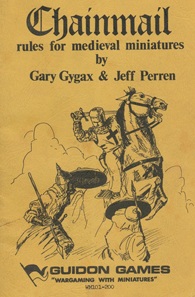Origins
In 1967, Henry Bodenstedt created the medieval wargame Siege of Bodenburg , which was designed for use with 40mm miniatures. [1] Gary Gygax first encountered Siege of Bodenburg at Gen Con I (1968), and played the game during that convention. [2] The rules for Siege of Bodenburg had been published in Strategy & Tactics magazine, and Jeff Perren developed his own medieval rules based on those and shared them with Gary Gygax. [1]
The original set of medieval miniatures rules by Jeff Perren were just four pages. [3] Gygax edited and expanded these rules, which were published as "Geneva Medieval Miniatures", in Panzerfaust magazine (April 1970), using 1:20 figure scale. [3] The rules were again revised, and then self-published in the newsletter of the Castle & Crusade Society, The Domesday Book, as the "LGTSA Miniatures Rules", in issue #5 (July 1970), using 1:10 figure scale. [3] Later issues of The Domesday Book introduce a rule system for man-to-man combat at 1:1 figure scale and a rule system for jousting. [4]
1st edition
Gary Gygax met Don Lowry at Gen Con III (1970), and Gygax later signed with Lowry when he founded Guidon Games to produce a series of rules called "Wargaming with Miniatures". [3] The first game published was a further expansion of the medieval rules, published as Chainmail. [3] Guidon Games released the first edition of Chainmail in 1971 as its first miniature wargame and one of its three debut products. [5]
Along with the previous medieval rules, Chainmail included a 14-page "fantasy supplement" including figures such as heroes, superheroes, and wizards. [3] The fantasy supplement also included mythical creatures such as elves, orcs, and dragons. [4] [6] The fantasy supplement also referenced the works of J. R. R. Tolkien, Robert E. Howard, Poul Anderson, and Michael Moorcock. [7] The fantasy supplement encouraged players to refight fixed battles based on fantasy fiction by J. R. R. Tolkien, Robert E. Howard, and other writers. [8]
The Chainmail cover art of a fighting crusader was inspired by a Jack Coggins illustration from his book The Fighting Man: An Illustrated History of the World's Greatest Fighting Forces. [2] Both Perrin and Gygax "swiped" Coggin's artwork to illustrate their preliminary articles about Chainmail that appeared in Panzerfaust and The Domesday Book. [2] When Don Lowry of Guidon Games agreed to publish Chainmail, Lowry swiped the same Coggins illustration for the cover. [2] For the fantasy supplement, the illustration of a mounted knight charging towards a dragon, was drawn by Don Lowry, based heavily on an illustration by Pauline Baynes for J. R. R. Tolkien's Farmer Giles of Ham (1949). [2]
First edition Chainmail saw print in March 1971. It quickly became Guidon Games' biggest hit, selling one hundred copies per month. [9]



